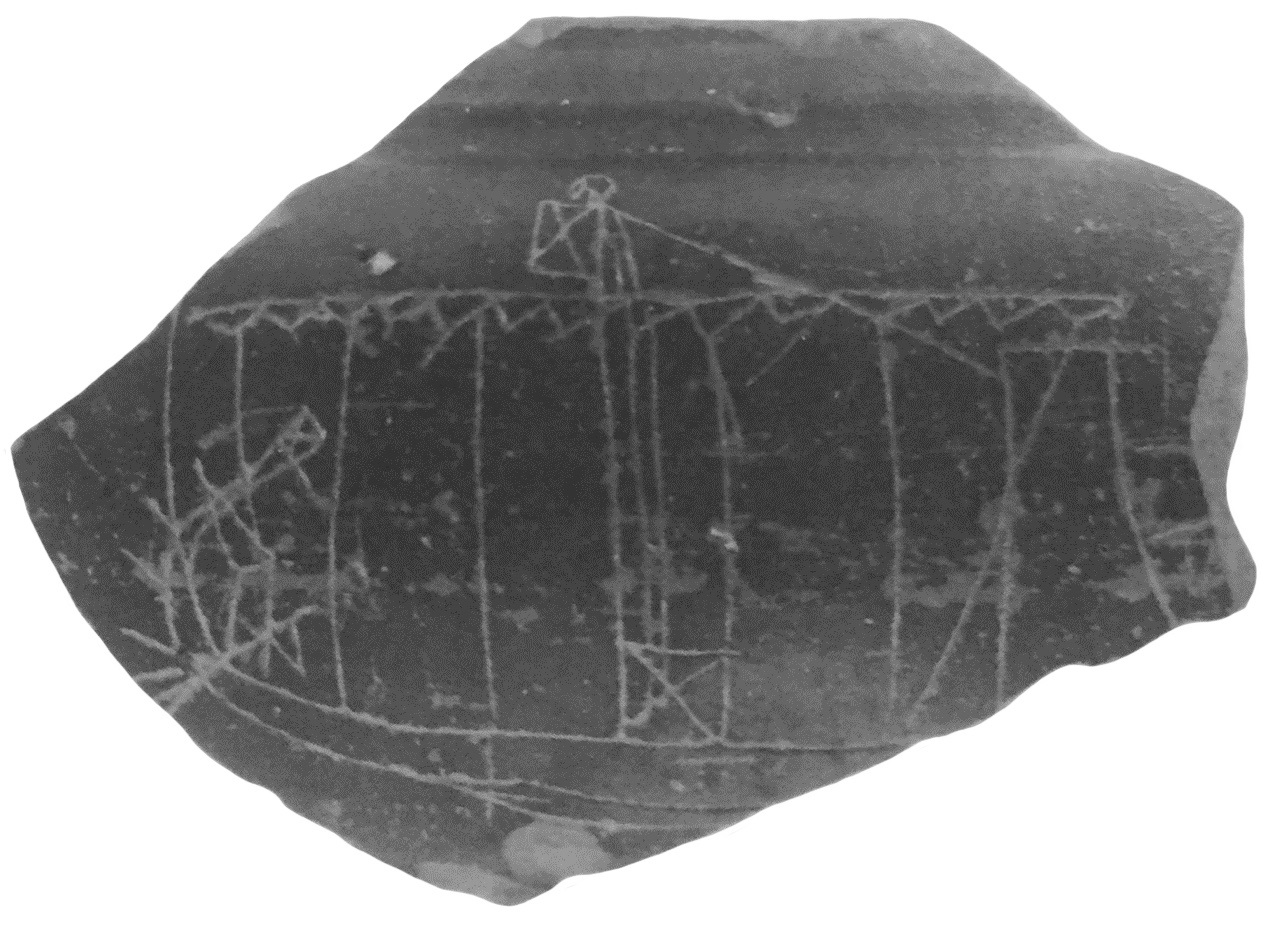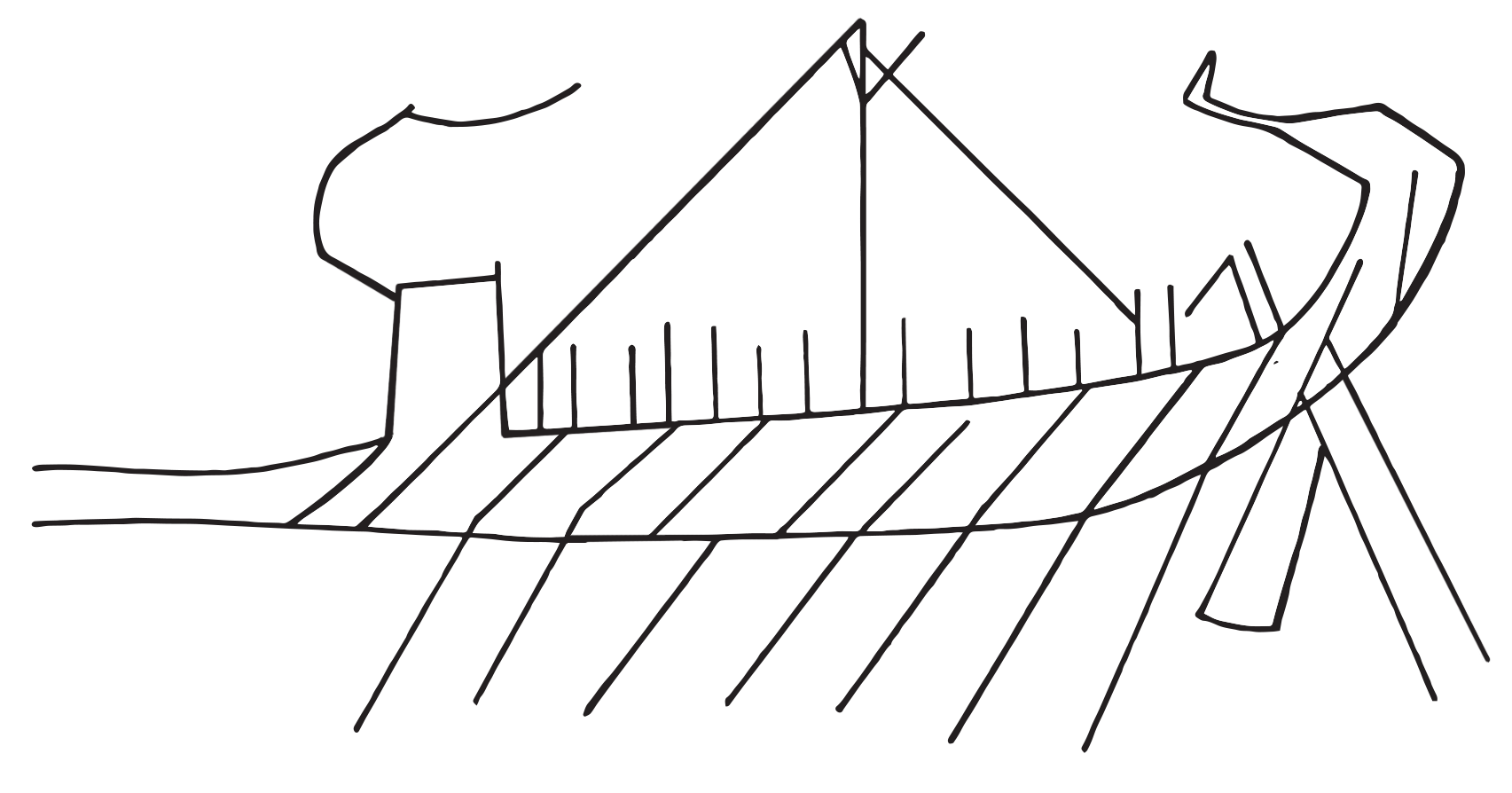A52a: single-levelled ship to the left with
a low flat hull. The bow is rectangular, with a concave stempost
integrating a very long bow projection that is as thick as the hull and
ends in a flat rectangular tip. The stempost ends in an S-shaped
incurving horn that inclines forward, then bends sharply backward
parallel to the hull and finally curves upward toward the tip. The
device is oddly attached, beginning midway down the stempost. The
sternpost is high and incurving, rising steeply then bending sharply
inward into a tapering extremity. The hull is hatched with diagonal
lines, including the bow and ram but not the stern. Above the gunwale
are sixteen vertical stanchions. Tzahou-Alexandri argues that these
represent a railing yet they do not support a horizontal rail. There are
eight oars with spade-shaped oar bladed emerging below the keel line.
These are not for the most part aligned with the hatching of the hull.
The quarter rudder has a tiller and is supported by a stanchion. The
mast is amidships, with a forestay, a backstay, and a forked or bisected
top. The yard is raised to the top of the mast. It is straight and
extends to the bow and stern respectively, with a furled sail depicted
by ten triangles hanging from it - five on either side of the mast.
A52b: this ship is similar to the previous one, with the following
differences. The hull is shorter and thicker. It is still hatched, but
the diagonal lines are spaced more widely and continue along the
sternpost but are absent from the ram. There is no yard or sail
depicted, and the oars lack oar blades. There appear to be two quarter
rudders.
Two galleys with hoplites
A54a-b
End of 3rd quarter of 8th century B.C.
Tomb 106, 23-24 Kriezi Square, Athens
L: 41 cm; W: 1.8 cm
Gold band comprised of a very thin sheet. There are holes from the compass used for the central motifs and the hoplite shields
Kerameikos Museum
Basch 1987: 187, no. 393; Christopoulos et al 1971: 202; Higgins 1980: 96; Tzahou-Alexandri 1990: 336-39, 356-58, figs. 11-13, 15-17, 19-22
Gold bands appears in Attic graves during the 9th century, and are usually decorated with simple geometric patterns. For the period EG II to LG II, there are twenty four specimens in total from the three main cemeteries which are located close together in the northwest corner of Athens: ten gold diadems come from the Dipylon cemetery, seven from the Kerameikos. and seven from Kriezi Street. Other more sparsely distributed exemplars include three from the Erisychthon and Neleus Streets, two from Erechtheion Street, one from the junction of Diakou and Anapafseos Streets, and five from Kynosarges (Whitley 2003: 147). Whitley notes that whereas the development of figured decoration on diadems seems to parallel that of geometric figured pottery, the treatment of the themes in the two media is very different, and neither style appears to copy from the other. Contrary to the stiffness of figured scenes on Geometric vases, the bands are remarkably vivid, with animals typically shown in movement and action. The decoration on gold bands is typically curvilinear and orientalising. In addition to the gold band, tomb 106 contained three skyphoroid pyxides and a skyphos dated to the third quarter of the 8th century, with a terminus post quem of LG Ib. It is possible that these are older than the band, which has a purely funerary use. The repetition of identical images on gold bands as well as the accuracy and fineness of their design indicates the use of matrices made of hard material, which would have been hammered in positive into the gold sheet with a soft hammer. The gold band from tomb 106 is unique in that it does not use impression but is instead decorated using incision with a blunt edge tool.
The band is divided into metopes separated by triglyphs. The triglyphs are comprised of three vertical strips each, with the exception of two more elaborate ones which include a cross-hatched band between the vertical strips. Tzahou-Alexandri describes the decoration as follows: "The central panel is the largest and is filled with two superimposed horizontal designs. The main one is a waved motif formed by semicircles in two rows, the other is a lozenge chain. The representations of the two ships are at either side of the central panel. The two panels next to the ships each contain a horse, one of which is represented upside down, possibly due to a mistake of the craftsman. The two terminal metopes are larger and are decorated with a row of four hoplites with round shields. From behind each shield two spears project above and below. Two of the soldiers have been left unfinished, probably because of the thinness of the sheet. A row of dots borders the panel at the top and at the bottom."(Tzahou-Alexandri 1990: 336). There is a bird with a long neck facing the ship in the left panel.
Basch, L. 1987. Le musée imaginaire de la marine antique. Athens: Institut Hellénique pour la preservation de la tradition nautique.
Christopoulos, G.A, S. Philip and G. Phylactopoulos (eds.). 1971. History of the Hellenic World: Archaic Period. Athens: Ekdotike Athenon.
Higgins, R. A. 1980. Greek and Roman Jewellery. 2nd edition. London: Methuen.
Tzahou-Alexandri, O. 1990. “Contribution to the knowledge of 8th century B.C. Ship Representations,” in H.E. Tzalas (ed.) Tropis II: 2nd International Symposium on Ship Construction in Antiquity. Delphi 1987 (Hellenic Institute for the Preservation of Nautical Tradition). Athens: Hellenic Institute for the Preservation of Nautical Tradition, pp. 333-61.











